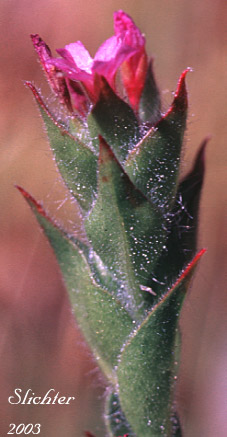 The
photo at the right shows dense spike-primrose found at Blue Ridge, Malheur National Forest.........July
2003.
The
photo at the right shows dense spike-primrose found at Blue Ridge, Malheur National Forest.........July
2003.
Dense spike-primrose is an annual wildflower with one erect, simple stem or plants may be openly branched. The herbage is variable, ranging from glabrous below to covered by long, soft hairs, or short hairs throughout.. Gland-tipped hairs may found amongst the other hairs on the upper part of the plants. The numerous leaves are lanceolate or linear-lanceolate with entire to toothed margins. The leaves range from 1.5-5 cm long and 3-10 mm wide.
The inflorescence is a leafy spike in which the bracteal leaves become wider, shorter and more crowded. These bracteal leaves become ovate-acuminate and clasping. The floral tube is 0.4-4 mm long with a hairy ring below the top. The calyx is erect, 2-6 mm long with the 4 calyx lobes narrow and cleft about 1/4-1/3 the length of the calyx. The 4 petals are rose-purple, pink, or white in color, 3-8 mm long and deeply notched at their tips.. The fruit is a sessile capsule from 5-10 mm long and 1.5-2.5 mm thick. The fruits are often hidden by the subtending bracteal leaf.
Dense spike-primrose grows along the drying margins of vernal ponds and streams, seeps and sesonally moist meadows from the lowlands to near 2000 meters in the mountains..
Dense spike-primrose may be found from British Columbia souththrough central Washington and Oregon to California and northern Baja California and east to south-central Idaho, western Montana, and northern Utah.